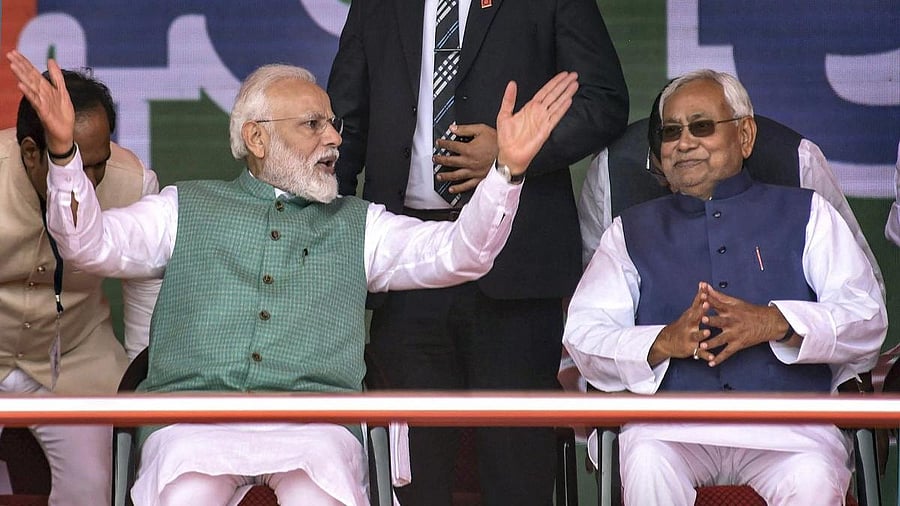
PM Narendra Modi and Bihar CM Nitish Kumar
Credit: PTI Photo
The “Union of States” is built on the principle of federalism, where equitable growth is expected across all states. The idea of federalism must not be limited to political federalism, but it must be equitable when it comes to the allocation and funding of projects by the Union government.
However, when it comes to centrally sponsored projects and their funding, this balance has been largely missing. Over the decades, states like Gujarat, Karnataka, and Haryana have received substantial investments and infrastructural support, while states like Bihar, Odisha, and West Bengal have been left behind, struggling to compete economically.
Over the past four decades, India's states have experienced varying levels of economic growth, largely influenced by their ability to capitalise on economic reforms and the support received from the Union government. By examining the Net State Domestic Product (NSDP) of Gujarat, Karnataka, Haryana, Bihar, Odisha, and West Bengal over three key periods — 1980-1981 (pre-liberalisation), 2001-2002 (a decade after liberalisation), and 2022-2023 (current scenario) — we can see stark differences in economic trajectories that underscore the impact of centrally sponsored projects and infrastructure investments.
Gujarat and Karnataka had NSDPs of ₹6,547 crore and ₹5,587 crore, respectively, in 1980-1981. Bihar, with a similar NSDP of ₹6,349 crore, showed promise for robust growth. However, fast forward to 2022-2023, and the differences are stark. Gujarat's NSDP soared to ₹19,46,334 crore, while Bihar's NSDP lagged at ₹6,81,761 crore.
This economic divide can be attributed to the uneven distribution of centrally sponsored projects and the investments directed by the Union government. States like Gujarat, Karnataka, and Haryana benefited from substantial Union government-backed projects, accelerating their industrial and economic growth. For instance, Karnataka's NSDP increased by 404.9 times between 1980-1981 and 2022-2023, while Bihar’s growth was only 107.3 times. The growth trajectories of Odisha and West Bengal also highlight this disparity. Odisha grew its NSDP by 217.8 times during this period, but it still lagged behind states that received better financial support.
In the early years after Independence, the Freight Equalisation Policy led to the entire country’s development at the expense of mineral-rich states like Bihar, Odisha, and West Bengal. Industries were established far from these resource-rich regions, leaving them underdeveloped while contributing to the growth of other areas. The liberalisation period further widened this gap, as states that were better positioned to attract investments reaped the benefits, while others fell behind.
The moot point is clear: Bihar, Odisha, and West Bengal have been systematically denied an equitable share of centrally sponsored projects, leading to their slower economic growth. This unequal distribution of resources has long-lasting impacts on state economies and the livelihoods of their citizens.
Role of mega projects
Centrally sponsored mega projects have proven to be game changers for state economies. The Mumbai-Ahmedabad High-Speed Rail project, commonly known as the bullet train project, is an example. Estimated to cost ₹1.08 lakh-crore, this project is a collaborative effort involving the Union government, the Government of Japan, and the states of Gujarat and Maharashtra. With over 80% of the funding provided through a soft loan from Japan, and the rest contributed by the Union and state governments, this project demonstrates the potential of centrally sponsored projects to transform regional economies.
By drastically reducing travel time between Mumbai and Ahmedabad, the bullet train is expected to spur economic activity, create jobs, and boost connectivity in the region. Over 90,000 direct jobs and indirect jobs are expected to be created, spanning construction, engineering, and manufacturing sectors. The project will not only enhance mobility but will also stimulate the growth of ancillary industries like tourism and hospitality, thereby boosting state tax revenues through increased economic activity, GST collections, and corporate taxes.
However, the benefits of such mega projects have not been evenly distributed across the nation. While Gujarat continues to receive substantial investments, Bihar and Odisha remain on the sidelines, awaiting their share of transformative infrastructure projects.
The economic growth of Indian states is intricately tied to the support they receive from the Union government in terms of centrally sponsored projects. The inequitable distribution of resources highlights the need for a more balanced approach to ensure that all states can participate in the nation’s economic growth.
To bridge the economic divide between states, it is imperative that the Union government reassess its project allocation strategy and ensure that lagging states receive the necessary support to foster development. Only by doing so can India, as a ‘Union of States’, achieve truly inclusive and balanced growth.
(Sudhakar Singh is a Lok Sabha MP representing Buxar, Bihar. Sarish Tripathi is a post-graduate in public policy from NLSIU, Bangalore.)
Disclaimer: The views expressed above are the author's own. They do not necessarily reflect the views of DH.